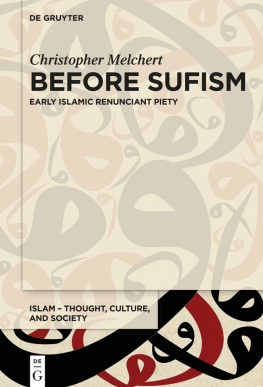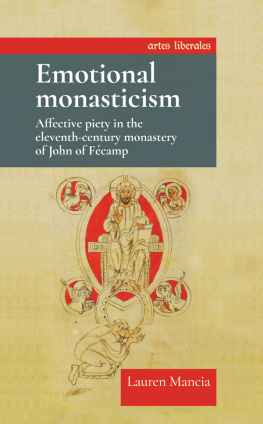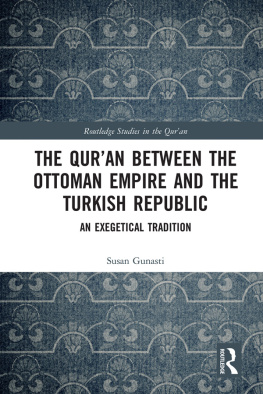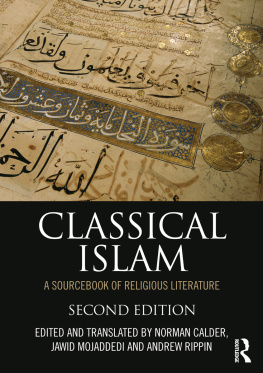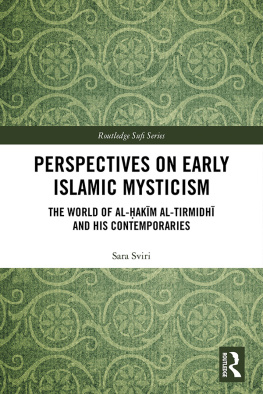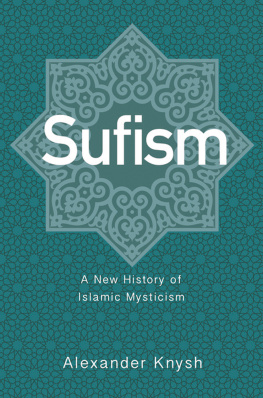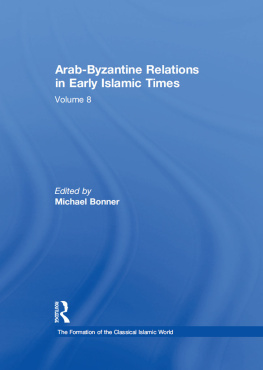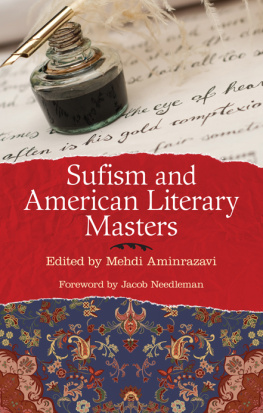Contents
Guide

Christopher Melchert
Before Sufism
Islam Thought, Culture, and Society

Volume 4

ISBN 978-3-11-061651-4
e-ISBN (PDF) 978-3-11-061796-2
e-ISBN (EPUB) 978-3-11-061771-9
ISSN 2628-4286
Library of Congress Control Number: 2020937392
Bibliographic information published by the Deutsche Nationalbibliothek
The Deutsche Nationalbibliothek lists this publication in the Deutsche Nationalbibliografie; detailed bibliographic data are available on the internet at http://dnb.dnb.de.
2020 Walter de Gruyter GmbH, Berlin/Boston
Cover image: Calligraphy by Osman zay. With friendly permission.
www.degruyter.com
Conventions
There are two major systems of transliteration from Arabic to English, those of The Encyclopaedia of Islam followed by most specialized journals and of the Library of Congress followed by library catalogues. The EI standard sometimes offers a closer transcription of Arabic pronunciation (e.g., f l-arq as opposed to f al-arq , although fi -arq would be closer still) while the LOC standard more closely follows Arabic spelling (e.g., LOC for alif in the form of y as opposed to EI for every alif , although even LOC does not distinguish between the two forms of alif in hdh , for example, as it is usually spelt in Arabic). The LOC standard is more internally consistent in its treatment of t marbah (e.g., qayah and quh as opposed to qaiyya and qut ) and sometimes more accurate as to the pattern ( wazn ) of the Arabic (e.g., LOC nubwah and qayah accurately suggesting fulah and falah , respectively, as opposed to EI nubuwwa and qaiyya suggesting fuulla and failla ). This book therefore follows the LOC standard.
Dates will normally be provided first after the Hijri calendar, then according to the Common Era; e.g., 211/827, the year when Abd al-Razzq died. Since a Hijri year usually intersects two C.E. years, accurate conversion of Hijri year to C.E. may require a split date; e.g., 255/8689, when al-Ji died, since the Hijri month specified in our sources intersects December and January in two different C.E. years. Sometimes, our sources offer more than one date of death, indicated here by a question mark; e.g., 161/777?, one reported date for the death of Sufyn al-Thawr (Amad ibn anbal), as opposed to 161/778 (Ibn Sad) and 162/7789 (Khalfah ibn Khayy), among other reported dates. References to centuries will be to those of the Common Era unless expressly noted; e.g., the ninth century, overlapping but not exactly coinciding with 184288 H.
Of some basic texts, there are too many commercial editions in circulation, without any standard edition to be preferred, for citation by volume and page to be appropriate. Outstandingly, the Six Books and some other major collections of hadith will be cited in this style: collector, title of book (i.e., chapter), title of section, number of hadith report. For example, Bukhr, al-shahdt 9, bb l yashhadu al shahdat jawr , no 2651 indicates one appearance in his a of the Prophets saying, The best of you is my generation ( qarn ), then those who follow them, then those who follow them. This is the form most likely to be traceable Other editors numbers have become effectively conventional for the collections of Ab Dwd and al-Nas, respectively those of Muammad Muy al-Dn Abd al-amd and Muammad A Allh al-Fjayn al-Amritsar. As for al-Nas, al-Sunan al-kubr , another major collection not now counted among the Six Books, its first complete and apparently most widely disseminated edition is that edited by Abd al-Ghaffr al-Bundr and Sayyid Kisraw asan. A superior edition has appeared from asan Abd al-Munim Shalab, supervised by Shuayb al-Arna, but its numbers are not widely cited; still, my references to it (abbreviated as SK ) will be first to numbers in the Bundr-asan edition, then in the Shalab.
The Quran quoted in translation will be that of Alan Jones. In the early centuries, the Quran was recited according to multiple textual traditions (readings), differing slightly as to diacritical marks and vowels. Over time, ten traditions came to be recognized as valid for recitation in the ritual prayer. The one most widely disseminated today is that of af (d. 180/7967?) from im (d. 127/745?), on which was based an influential Egyptian printing in the 1920s. In the early centuries of Islamic scholarship, there was a large literature concerning how to divide the Quran into verses ( adad y al-Qurn ). Over time, there came to be five recognized systems. Again, the reading and the versification of the Egyptian printing of the 1920s are those followed by Jones and now almost all scholars.
I use a few abbreviations in the text. L. stands for lived (in some place), d. for died, bef. for before, cl. for client (meaning a Muslim not ancestrally Arab), sim. for similar or similarly, alt. for alternatively, rec. for recension of when a title is extant in significantly different recensions. Fl . is floruit (for someone whose death date is unknown), r . is regnat for the reign of a caliph. One acknowledgement is necessary of extraordinary support for this book: it was framed and largely written during a sabbatical year (201415) spent at the National Humanities Center in Research Triangle Park, North Carolina, supported by a John G. Medlin, Jr., Senior Fellowship.
Chapter 1: Basic problems
The topic
The topic of this book is early Islamic renunciant piety, which seems to have predominated before the rise of classical Sufism in the later ninth century. To state my history with utmost brevity, I might say that the renunciant piety of the eighth century was about preserving the ethos of the conquest period after the conquests were over. It became increasingly unfeasible as the military was professionalized and more and more people converted to Islam. It was one thing to call for Muslims to spend most of their nights in prayer and quranic recitation when the Muslims were a thin stratum at the top of society, supported by tribute from the conquered peoples. It was quite another thing to call for that when Muslims had become the majority and most of them necessarily had to work for a living. Active distrust of the life of austerity began to be respectable from about the last third of the eighth century, even as enthusiasts embraced new, more extreme forms. Following some active persecution of Sufis, a new synthetic piety crystallized around al-Junayd (d. 298/911?) in Baghdad. This was classical Sufism, still calling for austerities but not for everyone; subordinating the old fear of God to cultivating mystical communion with the Divine.
In the following chapters, I shall try to present representative examples of renunciant devotions, accounts of how they were supported materially and their stance vis vis rulers, finally the rise of opposition to world-denying renunciation and the Sufi answer to that opposition. One of my theses is that it is possible to write about Islamic piety historically: to identify stages and to suggest why it moved in some directions rather than others. Scholars must reject the view, however comfortable to believers, that Sufism is a superhistorical essence manifest in the Prophets lifetime, manifest throughout the conquest period, manifest immediately after the conquest period.
The sources
The chief problem of writing early Islamic history is that so few of our sources are contemporary. That is, to know what happened in the seventh and eighth centuries we mainly have to rely on chroniclers and others of the ninth and tenth centuries. The risk is that chroniclers of the ninth and tenth centuries were projecting backward the ideas of their own time. Sometimes, the anachronisms are obvious, as when the Companions of the Prophet are supposed to have reverently listened Sometimes, it is contradictions among different versions of how something happened or what exactly was said that alert us to how little we can be sure of.

